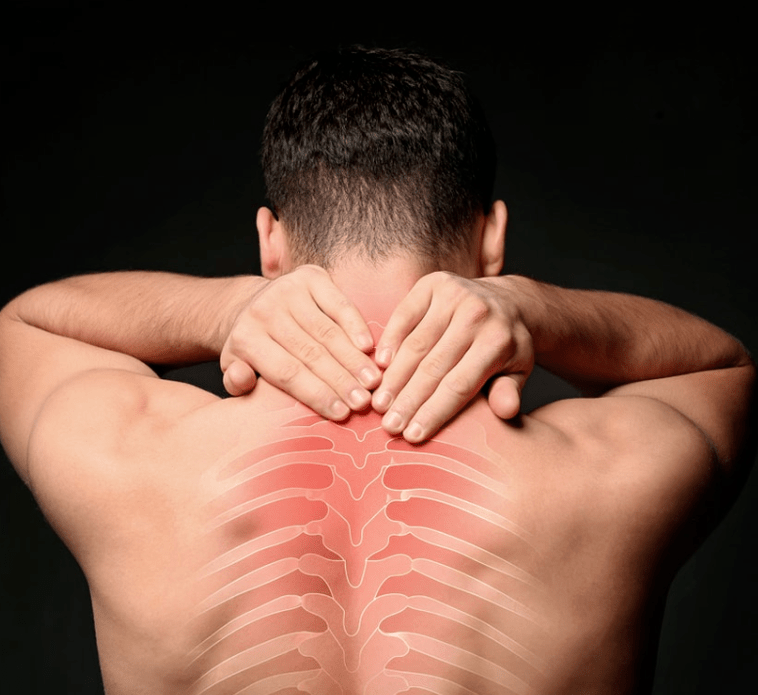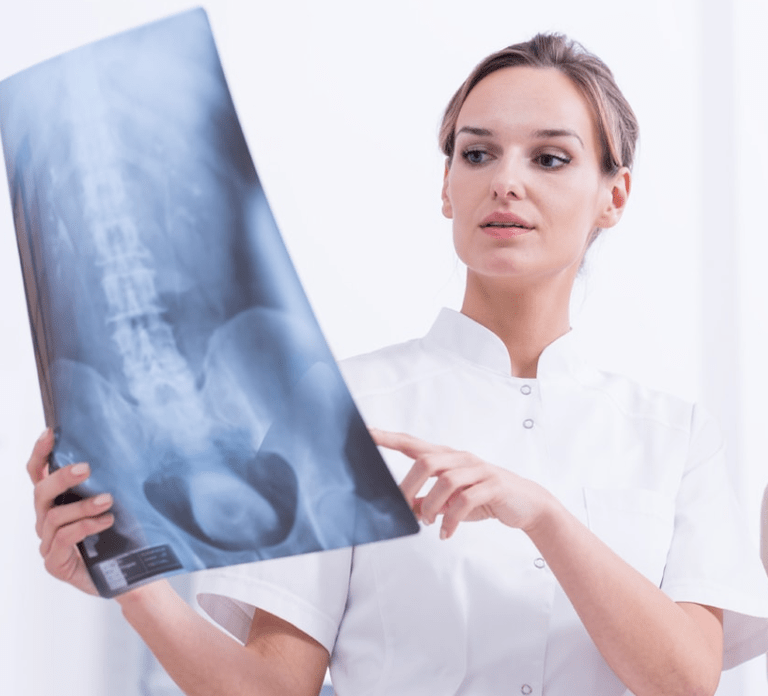
Bone tumors are the most common of all spinal diseases. Since direct osteonecrosis is a dystrophic degenerative lesion of the intervertebral discs, this leads to an irreversible change in their structure, as well as the shape of the discs. discs that make up the thoracic spine. .
As a person's age increases, these changes in the spine develop more and more, and by the age of 40-45, almost everyone develops spondylolisthesis. By itself, osteochondrosis of the thoracic spine develops much less often than, for example, the lumbar or cervical spine, since the vertebrae in it are much less mobile than in other vertebral regions. In addition, the back and chest area have a more developed muscle group, supporting the spine in the chest area much better than in other areas.
What is this thoracic osteonecrosis?
Bone necrosis in the chestdirectly represents the stratification of intervertebral discs with a concomitant decrease in their thickness and consequent compression of nerve endings located in the intercostal region of the human thorax.
However, we note again that because the physiological fixation of the human rib is rather rigid, the thoracic spine is least susceptible to osteonecrosis. Thoracic osteonecrosis is a rare occurrence, e. g. osteonecrosis of the neck or waist.
Most often, with osteosarcoma of the thoracic spine, the pathological process involves the intervertebral discs between the vertebrae of the thoracic spine, including the twelve thoracic vertebrae. But most commonly with thoracic osteonecrosis, pathological changes occur in the upper thoracic vertebrae. There are several degrees of injury with thoracic osteonecrosis, and we will consider them in more detail.
Prognostic factors for the development of thoracic osteonecrosis
The exact cause of the occurrence of osteonecrosis of the thoracic region has not been fully established by modern science. Currently, in medicine, it is common to distinguish the following predisposition factors, also known as risk factors, so that thoracic osteonecrosis occurs in the spine:
- genetic predisposition;
- excessive physical activity in this part of the spine;
- spinal cord injury, such as a fall or bruising in the chest area;
- changes that occur with age of the discs and lead to a decrease in hydration in the intervertebral disc tissues;
- violation of blood supply in the chest area.
Causes contributing to thoracic osteonecrosis
Essentially, the development of disease with osteonecrosis is often precipitated by hypomotility, i. e. , lack of muscle load, leading to impaired corset functions and consequent increase in the load on the muscle. discs and ligaments.
Other reasons for the development of thoracic osteonecrosis are:
- hypothermia of the body;
- the presence of chronic stressful situations;
- transfer infection;
- difficult manual labor conditions;
- arising hormonal disorders in the body;
- violation of metabolic processes in the body;
- the presence of congenital defects of the spine, namely its thoracic region.
During exposure to a combination of these factors, or sometimes even one, irreversible degenerative processes develop in the intervertebral discs over time:
- the medullary nuclei of the intervertebral discs begin to gradually lose the fluid they secrete to provide lubrication, eventually significantly reducing the disc's cushioning function;
- The fibrous ring of the vertebrae itself, due to the large load on it, becomes more vulnerable, which in turn leads to its gradual destruction.
Symptoms and signs of osteochondrosis of the thoracic spine
The clinical symptoms of thoracic osteonecrosis depend entirely on the following factors:
- the patient's age;
- disease severity;
- Stages of osteonecrosis of the thoracic spine: remission or resolution of the disease.
The main signs of thoracic osteonecrosis are:
- pain in the chest in the spine, the so-called back;
- painful damage to the nerve endings of the spinal cord - etiological disease;
- abdominal syndrome;
- cardiac syndrome or changes in the myocardium, with characteristic pain that persists even under the influence of trinitroglycerin;
- pulmonary syndrome, in the form of stagnation in the lungs with signs of hypoxia, ie asphyxia.
No increase in body temperature was observed in patients with thoracic osteonecrosis, which is also a direct differential diagnosis. Back pain in the thoracic region is one of the main symptoms of osteonecrosis indicating the appearance of cracks in the annular fibrosis and deformation of the nucleus pulposus. When palpated, the pain in this chest area is only more intense, the symptoms gradually increase.
In addition, the characteristic symptoms of thoracic osteonecrosis with compressive myelopathy, i. e. deformity of nerve endings, are:
- sensation of "goose bumps" - paresthesia;
- pain along the compressed nerve - are common symptoms;
- reduced sensitivity to temperature and to touch;
- Spinal motor dysfunction is also one of the characteristic symptoms.
When you discover such symptoms, you need to see a specialist. The appearance of symptoms in the complex and their intensity is especially dangerous. At the same time, it is not appropriate to treat the symptoms without eradicating the root causes and causative factors.
Degree of disease with thoracic osteonecrosis
Each degree of thoracic osteonecrosis is characterized by its own pathology, which has only its own clinical signs. Modern medicine distinguishes four degrees of degenerative disc disease of the thoracic region (analogue - degenerative disc disease of the lumbar and cervical spine) and, accordingly, four periods of its development. Let's look at them in more detail.
First level,which is characterized by cracks appearing within the annulus, where the pulp nucleus then penetrates. The advanced stage of the disease with thoracic osteonecrosis is characterized by the following symptoms:
- the appearance of pain in the spine does not extend beyond the localization of the lesion;
- these pains may be permanent or manifest as low back pain;
- May convulse the thoracic muscles, accompanied by pain in the heart area.
Second levelthe development of thoracic osteonecrosis is characterized by the pathological appearance of increased disc mobility with the following clinical manifestations:
- appendages appear in the thoracic spine;
- pain increases with movement;
- Discomfort appears with prolonged posture.
The third levelCharacterized by rupture of the annular fibrosus and expulsion of the pulp nucleus beyond its limit. In this stage, the disease has symptoms of osteochondrosis of the thoracic spine, disc herniation begins to appear, clinical signs are quite severe. Namely - neurovascular, muscle tonic and reflex-dystrophy.
In addition to the above, for the third degree of thoracic osteonecrosis, changes in the following conditions of the spine are characteristic:
- fixation of the position of the weak spine;
- limited mobility of the spinal region, manifesting as kyphosis or scoliosis.
Fourth degree- the degenerative degenerative process has affected all the structures surrounded by the spine. This pathological process involves the yellow, interstitial and other ligaments, and fibrosis occurs in the structures surrounding the spine. In this period of the disease with thoracic osteonecrosis, the so-called state of remission is clinically observed.
Complications
With further progression of the disease with thoracic osteonecrosis, it is possible to develop concomitant complications:
- inflammation of the nerve endings of the spinal cord;
- the appearance of a herniated disc;
- development of vascular dystonia;
- development of Schmorl's hernia;
- degenerative spondylolisthesis;
- bone growth pathology - bone-forming substances;
- significantly reduced in the spinal canal.
It should be noted that the severity of complications arising in thoracic osteonecrosis depends entirely on the rate at which the disease process has arisen and, of course, on the effectiveness of the treatments. disease of the thoracic spine.
Its diagnosis and methods

In fact, several methods are used to diagnose thoracic osteonecrosis. Of these, the most common are X-ray examinations, the results of which are quite informative. The signs of thoracic osteonecrosis detected in this study were as follows:
- the border of the discs between the vertebrae is broken;
- the edges of the bonding plates acquire a wavy character;
- the discs have changed shape;
- osteoblasts appear - the development of bone pathologies in the spine;
- the hook-shaped processes of the vertebrae have increased and sharpened;
- the trunk of the thoracic vertebrae has changed to its normal shape;
- the height of the discs between the vertebrae has decreased significantly;
- Formation of herniated discs between the vertebrae.
In some cases, a diagnostic method of thoracic spondylolisthesis is made by means of X-ray contrast studies, identifying the following signs of this disease:
- in case of advanced pathology, the contrast material completely fills the intervertebral disc;
- with the help of contrast, the contours of the pulp are visible, uneven;
- When the disc is destroyed, the contrast material largely penetrates beyond its limits, up to infiltrating the spinal canal.
Only an accurate diagnosis can determine the correct treatment.
Treatment of osteonecrosis
Treatment of thoracic osteonecrosis can be carried out in one of the following ways, used taking into account the diagnosis of thoracic osteonecrosis, namely:
- conservative-traditional treatment of the spine;
- treatment of thoracic osteonecrosis by traction;
- surgical intervention.
Treatment of osteonecrosis of the chest, called conservative, is complex to treat any type of osteonecrosis: drugs, physiotherapy, physiotherapeutic exercises. Non-steroidal anti-inflammatory drugs intended to relieve pain in the spine, known for osteochondrosis of the chest. It should be noted that these drugs very well eliminate inflammatory processes as well as swelling, helping to relieve the compression of nerve roots. In more complicated cases of osteonecrosis of the breast, the attending physician may prescribe some additional medications, for example, some strong pain relievers and muscle relaxants that prevent the occurrence of spasms. muscle.
When the pain is in remission or has been controlled to cease, i. e. during remission, physiotherapeutic treatment is prescribed, as well as therapeutic exercise and massage. These are all important components of a holistic treatment. One of the main physiotherapeutic tools for the treatment and prevention of disease is pulsed magnetic field therapy using special medical devices for clinical and home use.
Only the use of magnetic therapy with special parameters is allowed during exacerbations; There are medical devices to treat both acute and chronic pain. This system is also suitable for the treatment of cervical spine and cervical spine.
In addition to the above methods, traction therapy, i. e. treating thoracic osteonecrosis with special traction, can be successfully used to treat thoracic osteonecrosis. With this method, the muscles, tissues and ligaments of the disc are stretched, resulting in an increase in the distance between the discs. Even a millimeter and a half is enough to reduce swelling, eliminate compression, as well as relieve tension in the muscles adjacent to the spine. In any case, the main principle of conservative treatment is its complexity. The treatment will take a long time and often, this is the only way to hope for results.
But surgical intervention as a type of treatment for osteonecrosis is only recommended when treatments for osteosarcoma of the upper chest have not yielded the desired results.





































